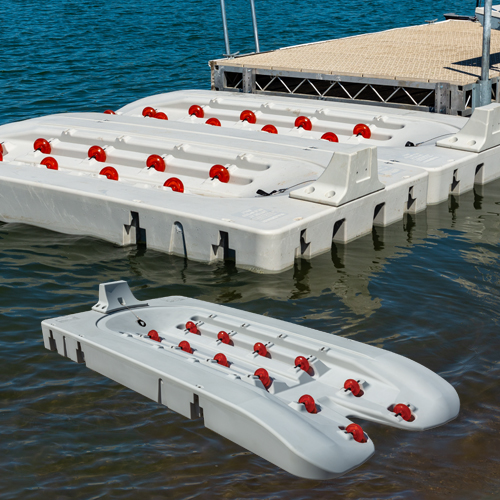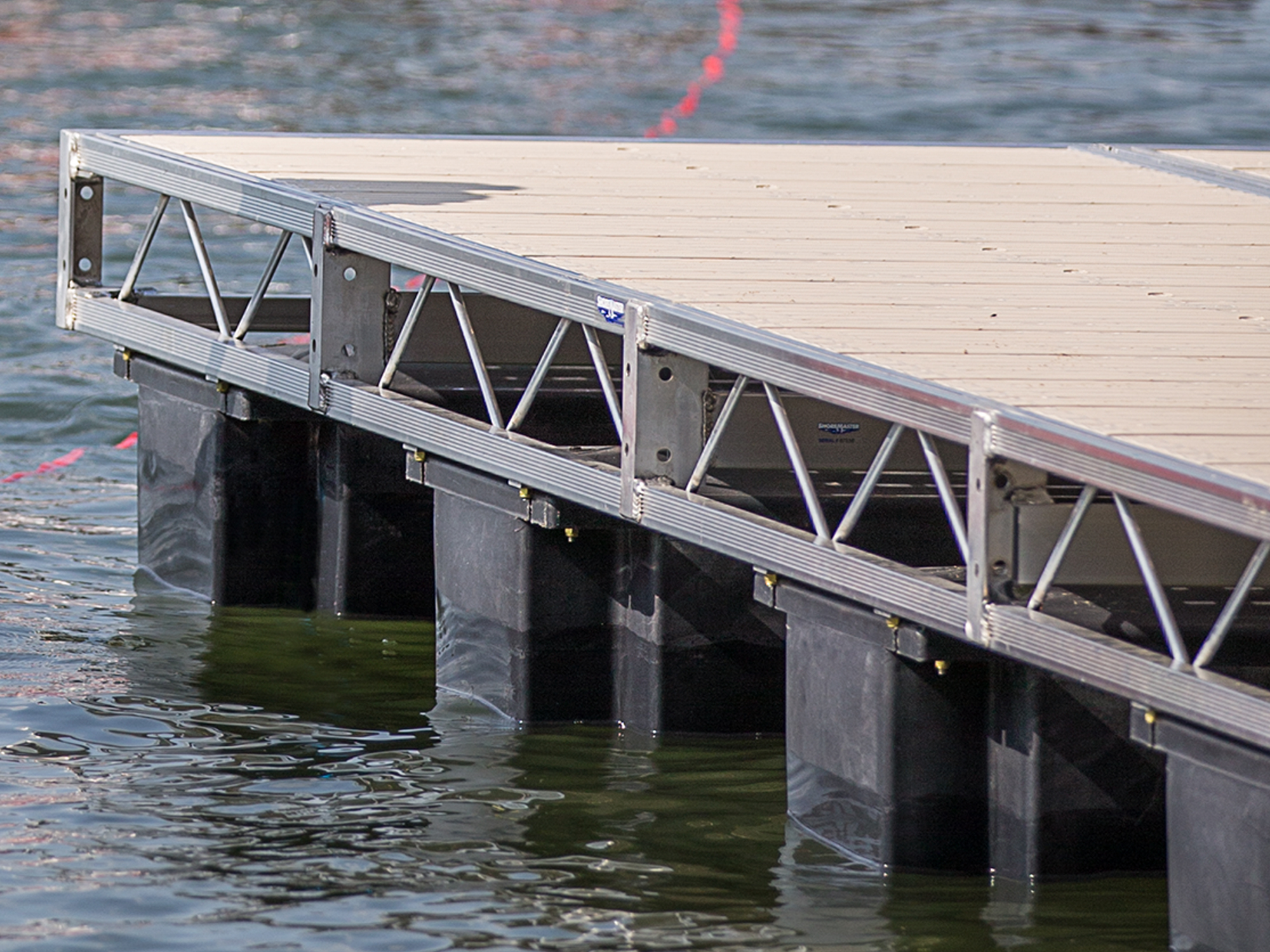Innovative Floating Docks: The Future of Beachfront Gain Access To and Recreation
Innovative Floating Docks: The Future of Beachfront Gain Access To and Recreation
Blog Article
Produce the Perfect Docking Solution With Floating Docks
Floating docks present a versatile option for a range of maritime requirements, adjusting seamlessly to rising and fall water levels and varied vessel kinds. As we check out the necessary elements that contribute to the effectiveness of floating docks, a number of crucial factors relating to stability and maintenance will arise, increasing concerns about exactly how to optimize your docking experience.

Advantages of Floating Docks
Floating docks offer various benefits that make them an optimal option for different maritime applications. Unlike dealt with docks, floating docks increase and loss with the trend, making certain constant accessibility for vessels.
Furthermore, floating docks are usually simpler and quicker to install compared to standard set structures. Their modular layout enables uncomplicated setting up and disassembly, promoting maintenance and moving when needed. This versatility is specifically valuable for short-lived applications or in environments where problems might change.
Floating docks additionally often tend to be more environmentally friendly, as they reduce disruption to the seabed and surrounding aquatic environments. Their buoyant nature reduces the risk of damages to aquatic life, advertising a healthier atmosphere. Moreover, these docks can be tailored to accommodate numerous vessel sizes, guaranteeing that they meet particular operational demands - dock company.
Eventually, the mix of adaptability, convenience of installment, and environmental factors to consider makes floating docks a very effective remedy for a vast array of maritime needs.
Picking the Right Products
Selecting the proper materials for floating docks is important to make certain longevity, stability, and long life. The choice of products directly impacts the dock's performance in numerous ecological conditions, including direct exposure to water, sunshine, and possible wear from aquatic traffic.
Typical products made use of for floating docks consist of aluminum, timber, and high-density polyethylene (HDPE) Aluminum is light-weight, corrosion-resistant, and requires marginal upkeep, making it a superb choice for longevity. Its preliminary expense can be higher compared to other materials.
Wood, while aesthetically enticing and offering a conventional appearance, can be vulnerable to rot and insect damage if not effectively dealt with. Therefore, using pressure-treated wood or naturally resilient varieties like cedar or redwood can minimize these issues.
HDPE is a preferred selection because of its resistance to UV rays and chemicals, along with being eco pleasant. dock company. It is lightweight and readily available in different shades, enabling for personalization
Ultimately, the appropriate product choice will rely on certain needs, consisting of budget plan, desired visual appeals, and environmental considerations. Mindful assessment of these variables will certainly bring about a effective and resistant floating dock service.
Design Considerations for Stability
When making floating docks, ensuring stability is a fundamental facet that can considerably influence their functionality and safety. Stability in floating dock design is influenced by various variables, including buoyancy, weight distribution, and the plan of elements. An optimum buoyancy system ought to use materials that provide sufficient lift while lessening weight. This equilibrium guarantees that the dock stays above water, also under differing loads.
Weight distribution is crucial; uniformly distributing tons across the dock prevents tilting and boosts security. Bigger designs can offer enhanced security, particularly in rough water i thought about this problems, while longer docks might need additional assistances to prevent sagging.
Another key factor to consider is the ecological impact, including wave activity and wind. Incorporating functions such as sidewalls or skirting can aid minimize the impacts of environmental forces, maintaining security in negative conditions. Ultimately, a mix of thoughtful design, product selection, and understanding of ecological factors will yield a drifting dock that satisfies both security and security needs.
Installment Tips and Techniques

Following, safeguard the needed licenses and stick to neighborhood laws, which may determine setup approaches and environmental considerations. Engage a qualified specialist experienced in floating dock installations if required. weblink Use premium products created for marine environments to enhance durability and longevity.
When positioning the dock, straighten it alongside the shoreline to assist in easy access. Make sure that the anchoring system is durable, employing cinder block or helical supports to maintain the dock versus wind and wave activity. It's essential to make up seasonal water level changes, including possible ice activity in cooler climates.
Throughout the installment, double-check the dock's floatation and stability prior to completing the anchoring. On a regular basis examine the setup for any type of indications of wear or damages. By adhering to these methods and ideas, you can accomplish a safe and secure, useful, and visually pleasing floating dock installment that fulfills your demands.
Maintenance and Care Standards
Preserving and caring for floating docks is essential to lengthening their life-span and making sure risk-free use. Regular evaluations must be performed to identify any indications of wear, damages, or aquatic growth. Search for fractures, loose fittings, or stained areas on the dock's surface, as these concerns can compromise structural integrity.
Cleansing is essential. Make use of a pressure washing machine to remove algae, barnacles, and particles, which can collect in time. For persistent development, think about eco pleasant cleaner that will not harm aquatic life.
In addition, inspect the mooring lines and anchors often to guarantee they are safe and complimentary from deterioration. Replace any frayed or harmed lines promptly to preserve security.
Throughout extreme weather condition, such as storms or freezing conditions, take preventive measures. Protect the dock with extra mooring lines and, if viable, get rid of any removable components to avoid damage.
Conclusion
Finally, the execution of floating docks offers a reliable and functional docking remedy appropriate for numerous maritime applications. Their flexibility to varying water degrees, combined with a modular design, permits for easy modification and moving. Picking suitable materials enhances both resilience and aesthetic allure, while cautious consideration of stability makes sure safety and durability. With proper installment and routine maintenance, floating docks can provide trusted and reliable docking experiences for a vast array of vessels.
As we discover the vital components that contribute to the efficiency of floating docks, a number of key elements relating to stability and upkeep will certainly emerge, increasing concerns regarding just how to optimize your docking experience. Unlike taken care of docks, floating docks increase and loss with the tide, ensuring consistent availability for vessels.When creating floating docks, making sure stability is an essential element that can dramatically impact their capability and safety and security. Stability in floating dock style Home Page is affected by various elements, consisting of buoyancy, weight circulation, and the setup of elements. Eventually, a mix of thoughtful design, material choice, and understanding of environmental factors will certainly yield a floating dock that fulfills both security and safety and security requirements.
Report this page